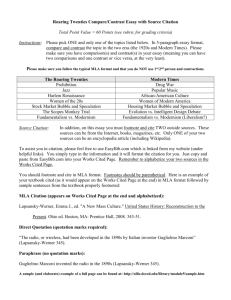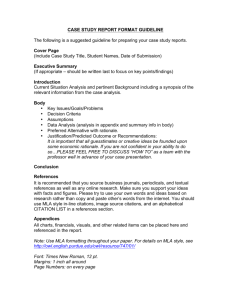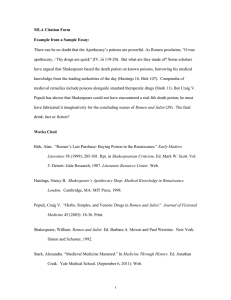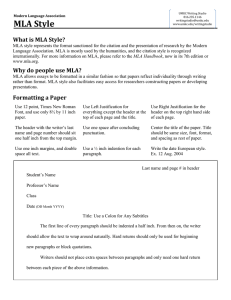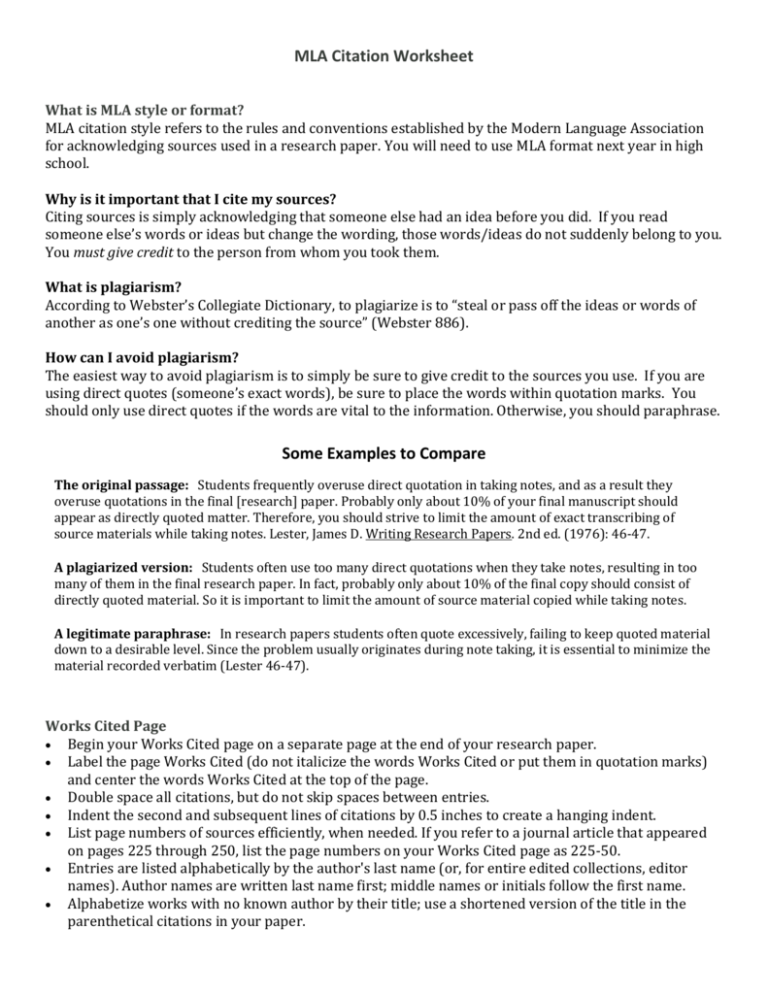
MLA Citation Worksheet
What is MLA style or format?
MLA citation style refers to the rules and conventions established by the Modern Language Association
for acknowledging sources used in a research paper. You will need to use MLA format next year in high
school.
Why is it important that I cite my sources?
Citing sources is simply acknowledging that someone else had an idea before you did. If you read
someone else’s words or ideas but change the wording, those words/ideas do not suddenly belong to you.
You must give credit to the person from whom you took them.
What is plagiarism?
According to Webster’s Collegiate Dictionary, to plagiarize is to “steal or pass off the ideas or words of
another as one’s one without crediting the source” (Webster 886).
How can I avoid plagiarism?
The easiest way to avoid plagiarism is to simply be sure to give credit to the sources you use. If you are
using direct quotes (someone’s exact words), be sure to place the words within quotation marks. You
should only use direct quotes if the words are vital to the information. Otherwise, you should paraphrase.
Some Examples to Compare
The original passage: Students frequently overuse direct quotation in taking notes, and as a result they
overuse quotations in the final [research] paper. Probably only about 10% of your final manuscript should
appear as directly quoted matter. Therefore, you should strive to limit the amount of exact transcribing of
source materials while taking notes. Lester, James D. Writing Research Papers. 2nd ed. (1976): 46-47.
A plagiarized version: Students often use too many direct quotations when they take notes, resulting in too
many of them in the final research paper. In fact, probably only about 10% of the final copy should consist of
directly quoted material. So it is important to limit the amount of source material copied while taking notes.
A legitimate paraphrase: In research papers students often quote excessively, failing to keep quoted material
down to a desirable level. Since the problem usually originates during note taking, it is essential to minimize the
material recorded verbatim (Lester 46-47).
Works Cited Page
Begin your Works Cited page on a separate page at the end of your research paper.
Label the page Works Cited (do not italicize the words Works Cited or put them in quotation marks)
and center the words Works Cited at the top of the page.
Double space all citations, but do not skip spaces between entries.
Indent the second and subsequent lines of citations by 0.5 inches to create a hanging indent.
List page numbers of sources efficiently, when needed. If you refer to a journal article that appeared
on pages 225 through 250, list the page numbers on your Works Cited page as 225-50.
Entries are listed alphabetically by the author's last name (or, for entire edited collections, editor
names). Author names are written last name first; middle names or initials follow the first name.
Alphabetize works with no known author by their title; use a shortened version of the title in the
parenthetical citations in your paper.
Common MLA Citation Formats
You probably only need to worry about the following citation formats, but if you find a resource does not
fall in one of these categories, go to https://owl.english.purdue.edu/owl/resource/747/01/ for more
information on MLA Formatting and Style.
Book
Author Last Name, Author First Name. Title of Book. City of Publication: Publisher, Year of Publication.
Medium of Publication.
Toupin, Laurie. Freshwater Habitats: Life in Freshwater Ecosystems. New York: Watts Library, 2004.
Print.
*If a book has more than one author, the first given name appears in last name, first name format; any
authors listed after that appear in first name last name format. For more than three authors, list the first
author and then the phrase “et al.” (Latin for “and others”) instead of listing all the other authors’ names.
Ex: Gillespie, Paula, and Neal Lerner…
Ex: Wysocki, Anne Frances, et al.
Article in a Reference Book (e.g. Encyclopedias, Dictionaries)
Author Last Name, Author First Name. “Title of Essay.” Title of Collection. Ed. Year of Publication.
Medium of Publication.
“Ideology.” The American Heritage Dictionary. 3rd ed. 1997. Print.
Article in a Newspaper
Author Last Name, Author First Name. “Title of Article.” Title of Periodical Day Month Year: pages.
Medium of Publication.
Brubaker, Bill. “New Health Center Targets County’s Uninsured Patients.” Washington Post 24 may 2007:
LZ01. Print.
Internet Site
Author Last Name, Author First Name. Title of the Section. Title of Overall Web Site (if different than title
of work). Publisher of site (if not available use n.p.), Day Month Year of Publication (if no date
available use n.d.). Medium of Publication. Day Month Year of Access. <electronic address>.
Nelson, Rob. The Taiga. Biomes of the World. The Wild Classroom, 2008. Web. 9 Dec 2008.
http://www.thewildclassroom.com/biomes/taiga.html.
In-Text Citations
MLA uses “author-page” in-text citation. Two types:
Romantic poetry is characterized by the "spontaneous overflow of powerful feelings" (Wordsworth 263).
Wordsworth extensively explored the role of emotion in the creative process (263).
Name: ___________________________
Date: __________________
MLA Practice Worksheet
Exercise: Below is a list of sources you may have used recently. Below each entry write the work using MLA
citation for a Works Cited page.
1. John Steinbeck wrote The Pearl in 1947. You are reading an edition of it published by Penguin Books
in 1992. Penguin Books is located in New York.
2. You wanted to learn more about John Steinbeck, and so looked him up in a reference book called The
Encyclopedia Americana. You used the 1994 edition of the book. It had an entry on John Steinbeck.
3. Your social studies textbook, entitled World History, was written by Elisabeth Gaynor Ellis and
Anthony Esler. It was published in 2007 by Pearson Prentice Hall, which is located in Boston,
Massachusetts.
4. You read a New York Times op-ed column by David Brooks entitled “Amy Chua Is a Wimp.” It was
published on January 18, 2011, and appeared on page A25 of the newspaper.
5. Oooops! You can’t find the op-ed column noted above, but the exact same piece appears on the New
York Times website. The URL address is http://www.nytimes.com/2011/01/18/opinion/18brooks.html
It was published the day before, on January 17, and the webpage is called “The New York Times: Opinion
Pages.” You referred to the article on December 19, 2012.






